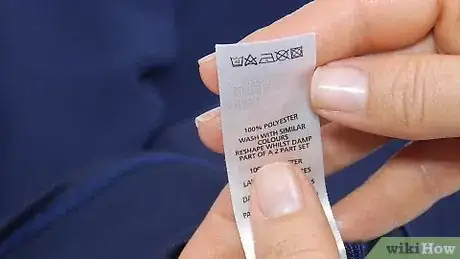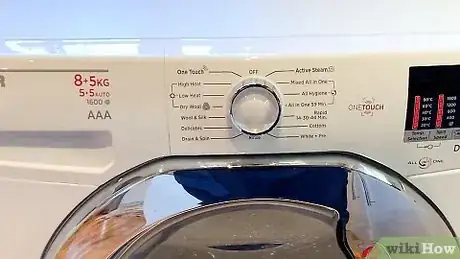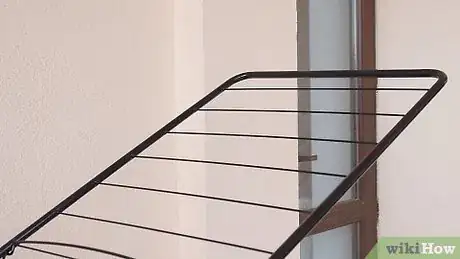This article was co-authored by wikiHow Staff. Our trained team of editors and researchers validate articles for accuracy and comprehensiveness. wikiHow's Content Management Team carefully monitors the work from our editorial staff to ensure that each article is backed by trusted research and meets our high quality standards.
There are 7 references cited in this article, which can be found at the bottom of the page.
The wikiHow Video Team also followed the article's instructions and verified that they work.
This article has been viewed 5,886 times.
Learn more...
Synthetics are manmade fabrics like polyester and nylon, which are common in many clothing items. Synthetics tend to be a little sensitive to heat, so drying them can be tricky. Fortunately, as long as the items are dryer-safe, it only takes a few extra steps to avoid damaging them. You can also air-dry synthetic fibers to avoid wear and tear. Either way, you can keep your synthetics looking fresh and new after a good washing.
Steps
Using the Dryer
-
1Read the item care tag to confirm that it’s dryer-safe. While synthetic fibers are usually dryer-safe, always refer to the item care label. If the label says that you can put the item in the dryer, then it’s safe to do so.[1]
- On care tags, a circle inside a box indicates that an item is safe to put in the dryer. Some more detailed ones might put a dot in the circle, telling you to keep the drying temperature low. If there's an X through the circle, then don't put it in the dryer.[2]
- Common synthetic fibers are polyester, nylon, spandex, acrylic, and rayon. Most are dryer-safe, but there are some forms of dry-clean only rayon.[3]
- Acetate is usually dry-clean only. Don’t put acetate items in the washer or dryer.
-
2Set the dryer to tumble dry on the lowest temperature. Even if items are dryer-safe, high temperatures can damage synthetic fibers. Set your dryer to the lowest temperature before you start drying.[4]
- If you’re worried about damaging the items, then air-drying them is best.
- Don't overload the dryer. Synthetics could wrinkle more if the dryer is overloaded.
Advertisement -
3Add a dryer sheet to prevent static cling. Synthetic materials are very susceptible to static cling, which can make them look wrinkly and unkempt. Always use a dryer sheet to prevent cling.[5]
- If you’re washing multiple items, try using 2 dryer sheets instead.
-
4Remove the items as soon as the dryer cycle is finished. Leaving items in the dryer after they’re done leads to wrinkling. Listen for when your dryer stops, then take the items out right away.[6]
- It’s best to fold and store the items as soon as you take them out of the dryer to reduce wrinkling.
Air-Drying Synthetic Fabrics
-
1Set up a clothesline or rack outside out of direct sunlight. If you want to reduce the chances of damaging synthetic items, then air-drying them is the best choice. Set up a clothesline outside or use a drying rack. Don’t put colored items in direct sunlight or they could get bleached.[7]
- You can also set up a drying rack inside, but open a nearby window or use a fan to speed the drying process.
- If you’ll be hanging your clothes outside, watch the weather and make sure it isn’t supposed to rain.
-
2Shake the items before you hang them to reduce stiffness. Grab each item from its corners and give it a firm shake or snap. This helps prevent wrinkling and stiffness during the drying process.[8]
- For the best results, shake the clothes as you’re taking them out of the washing machine. If you forgot to do that, you can shake them right before you hang them.
-
3Fold the items over the clothesline or rack. Open up the items so they’re flat and fold them over the line. Leave a few inches in between each item so there’s enough airflow to dry them.[9]
- You could also use clothespins keep the items in place. These are useful on a windier day.
-
4Lay the fabric flat to dry if the care tag tells you to. Since synthetics can wrinkle easily, some items tell you to lay them flat instead of hanging them to dry. The care tag will show a box with a line through the center if this is the case. If you see this symbol, then spread the items out flat on a table or laundry rack and leave them to dry.[10]
-
5Let the items dry for 2-4 hours. The drying time depends on how warm, windy, and humid it is. In most cases, your items will take 2-4 hours to dry, so monitor them and take them down when they’re all dry.[11]
- Remember to monitor the weather while your items are drying. If it suddenly gets cloudy and looks like it’s about to rain, bring everything back inside.
-
6Fold the items as soon as you remove them so they don’t wrinkle. Leaving fabrics rolled up in a bag or basket causes wrinkling. Fold each item carefully as you take it down, then store it in your drawer or closet as soon as possible.[12]
Things You'll Need
Using the Dryer
- Dryer
- Dryer sheets
Air-Drying Synthetic Fabrics
- Clothesline
- Laundry rack
- Clothespins
- Table
Warnings
- Always dry items according to their care label. The instructions there should overrule these.⧼thumbs_response⧽
References
- ↑ https://www.popsci.com/wash-clothes-without-wearing-out/
- ↑ https://www.pgeveryday.com/home/cleaning/how-to-read-a-laundry-tag
- ↑ https://www.yellowpages.ca/tips/6-timely-tips-for-cleaning-synthetic-fabrics/
- ↑ https://www.popsci.com/wash-clothes-without-wearing-out/
- ↑ https://www.yellowpages.ca/tips/6-timely-tips-for-cleaning-synthetic-fabrics/
- ↑ https://www.yellowpages.ca/tips/6-timely-tips-for-cleaning-synthetic-fabrics/
- ↑ https://www.bobvila.com/slideshow/the-dos-and-don-ts-of-air-drying-everything-you-own-52998#air-drying-clothes-in-direct-sun-will-naturally-bleach-your-whites
- ↑ https://www.bhg.com/homekeeping/laundry-linens/clothes/dry-clothes/
- ↑ https://www.bhg.com/homekeeping/laundry-linens/clothes/dry-clothes/
- ↑ https://www.pgeveryday.com/home/cleaning/how-to-read-a-laundry-tag
- ↑ https://www.bobvila.com/slideshow/the-dos-and-don-ts-of-air-drying-everything-you-own-52998#air-drying-clothes-not-down-comforters
- ↑ https://www.bobvila.com/slideshow/the-dos-and-don-ts-of-air-drying-everything-you-own-52998#air-drying-clothes-not-down-comforters

























































